
16 minute read
Técnicas de impressão | Printing techniques
from Ilustrare
133.
A obra “Köhler’s medizinal-pflanzen” (“Plantas medicinais de Koehler”), que foi baseada no trabalho extenso do médico e farmacologista alemão Hermann Adolph Köhler, viria a reunir um conjunto soberbo de 283 estampas de plantas primorosamente desenhadas por Walther Otto Müller e Carl Friedrich Schmidt, depois impressas em cromolitografias de alta qualidade gravadas por Karl Günther, no que viria a ser considerada como uma das mais úteis e excelentes séries de ilustrações de plantas (com interesse farmacológico) alguma vez desenhadas. Estas ilustrações viriam a estabelecer um padrão no desenho botânico, continuando ainda hoje a ser profusamente utilizadas na descrição das respetivas espécies. The work “Köhler’s medizinal-pflanzen” (“Koehler medicinal plants”), was based on the extensive research of the German physician and pharmacologist Hermann Adolph Köhler. It gathers a superb set of 283 botanical prints exquisitely drawn by Walther Otto Müller and Carl Friedrich Schmidt, and printed through high quality chromolithographs engraved by Karl Günther, considered today as one of the most useful and excellent illustration series on plants (with pharmacological interest) ever drawn. These illustrations establish a standard in botanical design, and continue to be extensively used today to describe the respective plant species. 132. Carvalho-alvarinho (Quercus pedunculata = Quercus robur) Common oak. 133. Genciana-amarela (Gentiana lutea) | Great yellow gentian. 134. Marmeleiro (Cydonia vulgaris = Cydonia oblonga) | Quince. 135. Dedaleira ou beloura (Digitalis purpurea) | Common foxglove. Impressão em cromolitografia * Walther Müller (ilustrador) in “Köhler’s medizinal-pflanzen in naturgetreuen Abbildungen mit kurz erläuterndem Texte”, 1887-98 | Chromolithography printing Walther Müller (illustrator) in “Köhler’s medizinal-pflanzen in naturgetreuen Abbildungen mit kurz erläuterndem Texte” 1887-98
Advertisement
Coleção particular | Private collection — N.Farinha

136. Dragão-da-floresta-de-Boulenger (Gonyocephalus interruptus = Gonocephalus interruptus) | Boulenger’s forest dragon. 137. Agamídeo-cabeça-de-leão (Calotes liocephalus) | Crestless lizard or lionhead agama. Impressão em litografia * R. Mintern e P. Smit (ilustradores) in “Catalogue of the lizards in the British Museum”, 1885-87 | Lithography printing * R. Mintern and P. Smit (illustrators) in “Catalogue of the lizards in the British Museum”, 1885-87
Coleção particular | Private collection N.Farinha
138. 138. Cobra-rateira-amarela ou caninana (Spilotes salvini = Spilotes pullatus) | Chicken snake or yellow rat snake. Impressão em litografia, pintada à mão * R. Mintern (ilustrador) in “Biologia Centrali-Americana — Reptilia and Batrachia”, 1885-1902 Hand-painted lithography printing * R. Mintern (illustrator) in “Biologia Centrali-Americana — Reptilia and Batrachia”, 1885-1902
Coleção particular | Private collection — N.Farinha
Estas reproduções de estampas antigas foram ligeiramente editadas, restauradas e limpas These reproductions of old prints were slightly edited, restored and cleaned
139. 142.
Estas reproduções de estampas antigas foram ligeiramente editadas, restauradas e limpas These reproductions of old prints were slightly edited, restored and cleaned
139. Palanca-azul (Hippotragus leucophaeus). Bluebuck or blue antelope. 140. Dondoro-do-cabo (Raphicerus melanotis). Cape or southern grysbok. 141. Cabrito-do-mato-comum (Sylvicapra grimmia). Common duiker. 142. Saiga (Saiga tatarica) | Saiga antelope.
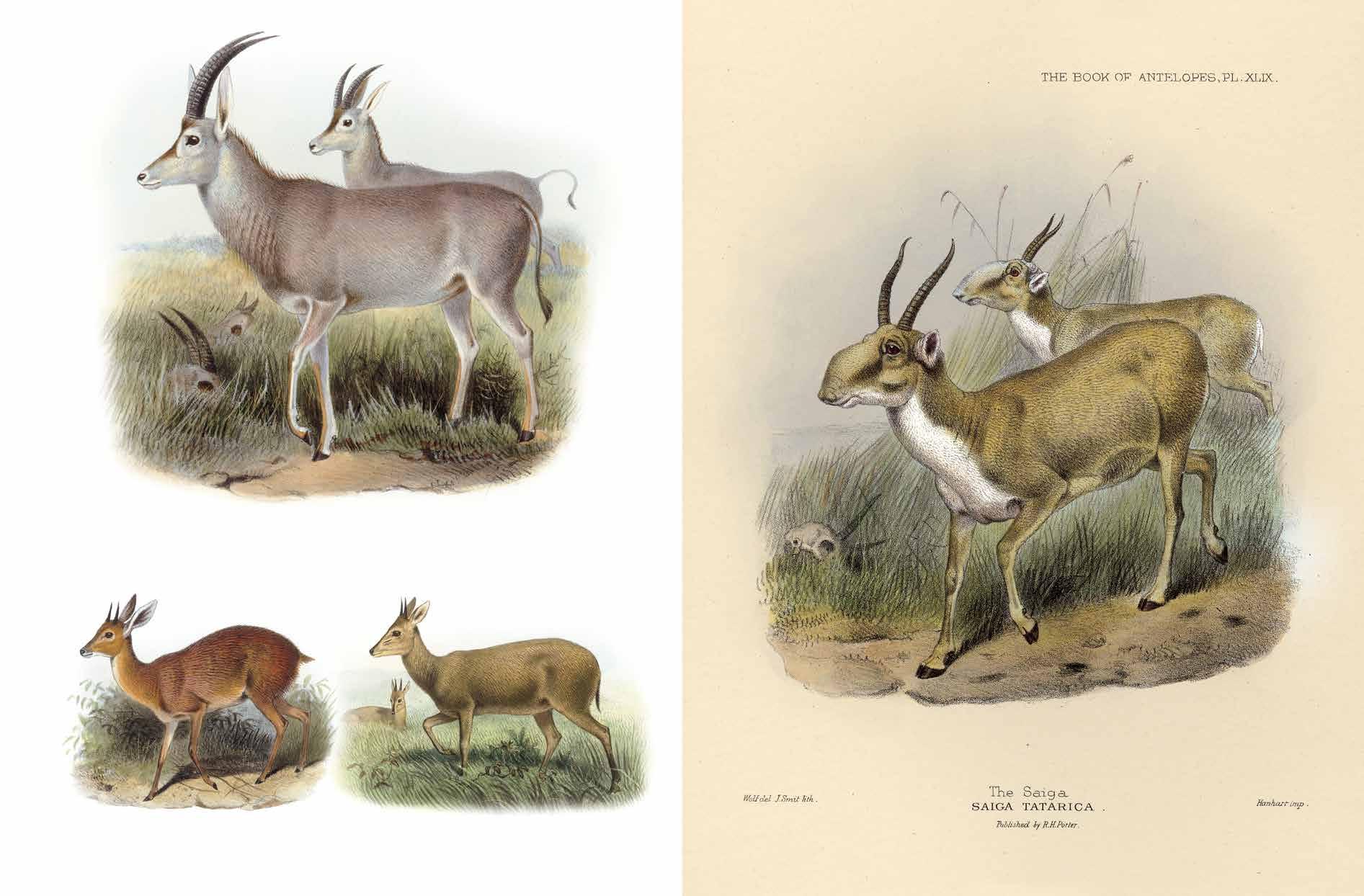
140. Impressão em litografia, pintada à mão * Joseph Wolf (ilustrador) e Joseph Smit (litógrafo) in “The Book of Antelopes” London, 1894-1900 Hand-painted lithography printing * Joseph Wolf (illustrator) and Joseph Smit (lithographer) in “The Book of Antelopes” London, 1894-1900
Coleção particular | Private collection — N.Farinha
141.
143. 144.
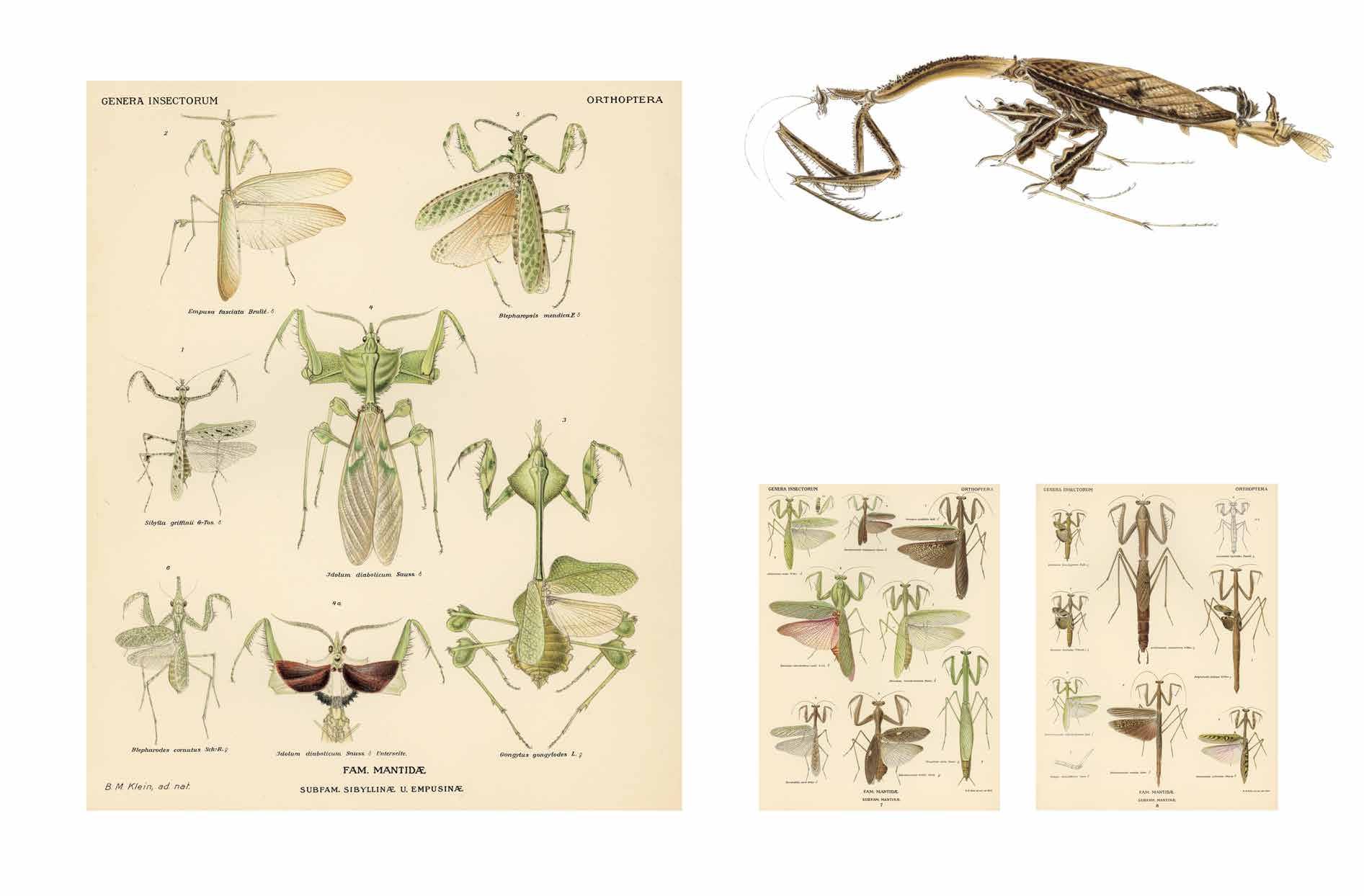
A coleção “Genera Insectorum” é uma série monumental de 219 fascículos coordenada pelo entomólogo belga Philogène Wytsman. The “Genera Insectorum” collection is a monumental series of 219 issues coordinated by the Belgian entomologist Philogène Wytsman. 143. Louva-a-Deus das subfamílias Sibyllinae e Empusinae Mantises from the Sibyllinae and Empusinae subfamilies. 144. Louva-a-Deus (Toxodera denticulata) da subfamília Toxoderinae Mantis (Toxodera denticulata) from the Toxoderinae subfamily. 145 - 146. Louva-a-Deus da subfamília Mantinae Mantises from the Mantinae subfamily. Impressão em cromolitografia * B.M. Klein (ilustrador) in “Genera Insectorum – Fascicules 197, 198 and 203 - Orthoptera: Family Mantidae” Bruxelles: Louis Desmet - Verteneuil, 1934 Chromolithography printing * B.M. Klein (illustrator) in “Genera Insectorum – Fascicules 197, 198 and 203 - Orthoptera: Family Mantidae” Bruxelles: Louis Desmet - Verteneuil, 1934
Coleção particular | Private collection — N.Farinha
145. páginas seguintes | next pages > A raríssima monografia “Icones Ornithopterorum”, escrita e desenhada pelo entomólogo inglês Robert Rippon, aborda algumas das maiores e mais belas borboletas do mundo. The scarce monograph “Icones Ornithopterorum”, written and illustrated by the English entomologist Robert Rippon, addresses some of the largest and most beautiful butterflies in the world. 147 - 148. Borboletas rabo-de-andorinha e afins Birdwing butterflies and alike. Impressão em litografia, pintada à mão * Robert H.F. Rippon (ilustrador e litógrafo) in “Icones ornithopterorum: a monograph of the Papilionine tribe Troides of Hubner, or Ornithoptera [bird-wing butterflies] of Boisduval”, 1898-1907 Hand-painted lithography printing * Robert H.F. Rippon (illustrator and lithographer) in “Icones ornithopterorum: a monograph of the Papilionine tribe Troides of Hubner, or Ornithoptera [bird-wing butterflies] of Boisduval”, 1898-1907 Acervo | Collection — Smithsonian Institution Libraries
147. 148.
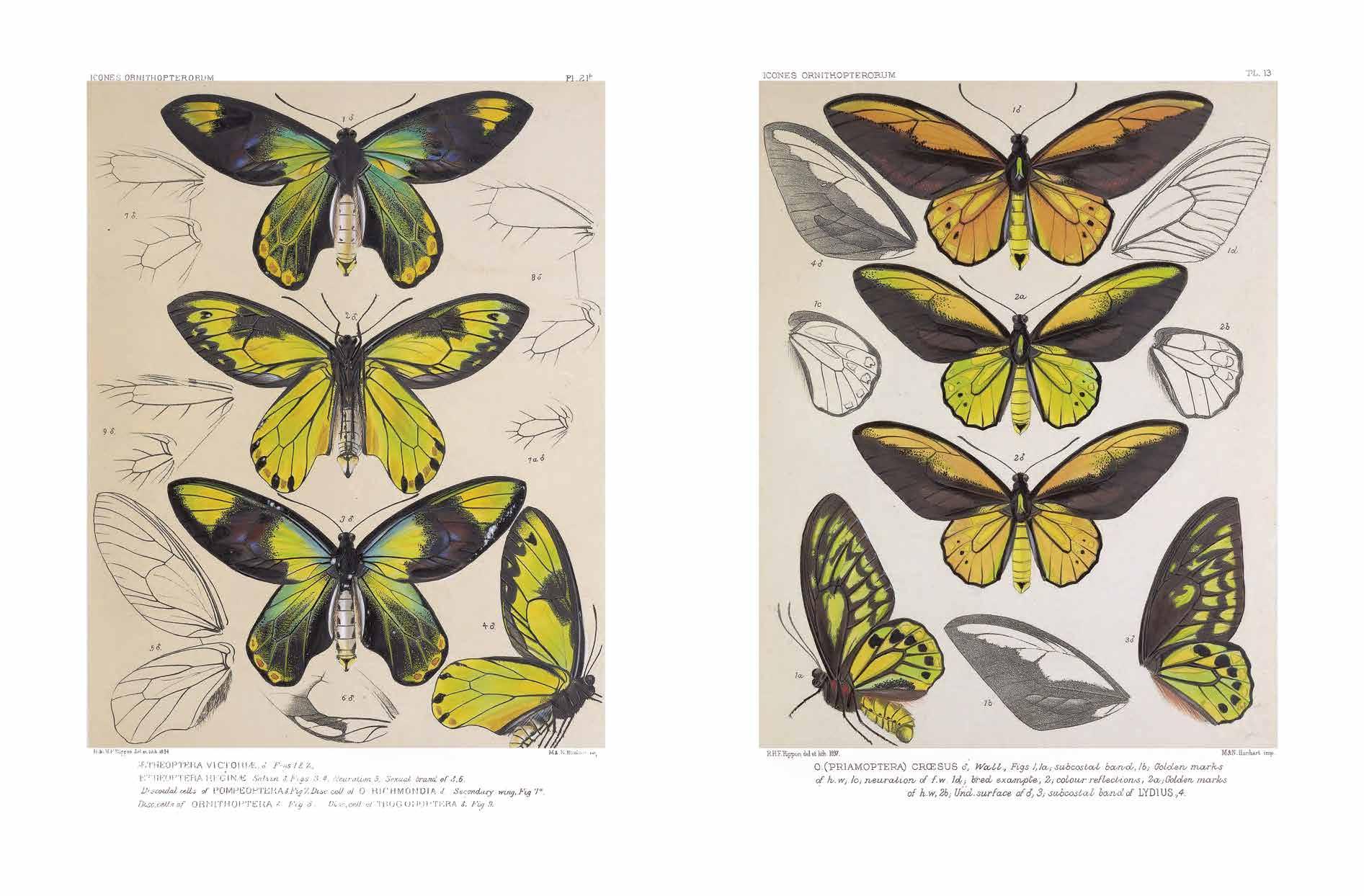
As campanhas científicas do príncipe Albert I do Mónaco constituem um dos maiores eventos de exploração oceanográfica já efetuados, compreendendo o esforço concertado de 28 campanhas realizadas entre 1875 e 1915, em quatro navios oceanográficos diferentes (L’Hirondelle I e II, e o Princesse-Alice I e II), pelas águas do Mediterrâneo, Atlântico e Árctico. Os resultados foram publicados numa coleção de 110 fascículos (editados entre 1889 e 1950), estando a maioria deles ilustrados com excelentes cromolitografias que retratam animais de grupos taxonómicos muito variados, como peixes, crustáceos, moluscos, ouriços e estrelas-do-mar, entre outros. O primeiro fascículo tratou precisamente da fauna malacológica dos Açores, um dos locais de investigação preferidos pelo monarca monegasco, pela facilidade de acesso a águas abissais profundas em locais bastante perto da costa. The scientific campaigns of Prince Albert I of Monaco are one of the largest oceanographic exploration events ever carried out, comprising a concerted effort of 28 campaigns that took place between 1875 and 1915, on four different oceanographic vessels (L’Hirondelle I and II, and the Princesse-Alice I and II), all along the Mediterranean, Atlantic and Arctic waters. The results were published in a collection of 110 issues (edited between 1889 and 1950), most of them illustrated with excellent chromolitho- graphies depicting animals from different taxonomic groups, such as fish, crustaceans, mollusks, sea urchins and sea stars, among others; the first issue is about the Azores malacological fauna. The Azorean waters were a hotspot to the Monegasque monarch because of the easy access to deep abyssal waters quite close to the coast. 149. Caranguejo-dentado ou sapateira-dentada (Cancer bellianus) | Toothed rock crab. Impressão em cromolitografia * J. Huet (ilustrador) e M. Borrel (litógrafo) in “Crustacés décapodes provenant des campagnes du yacht l’HIRONDELLE (1886, 1887, 1888) — Première Partie: Brachyures et Anomoures” Monaco, 1894 Chromolithography printing * J. Huet (illustrator) and M. Borrel (lithographer) in “Crustacés décapodes provenant des campagnes du yacht l’HIRONDELLE (1886, 1887, 1888) — Première Partie: Brachyures et Anomoures” Monaco, 1894 150. Ofiurídeo (Gorgonocephalus agassizi = Gorgonocephalus arcticus) | Basket star. Impressão em cromolitografia * R. Koehler (ilustrador) e Lovatelli (litógrafo) in “Échinodermes provenant des campagnes du yacht Princesse-Alice (Astéries, Ophiures, Échinides et Crinoïdes)” Monaco, 1909 Chromolithography printing * R. Koehler (illustrator) and Lovatelli (lithographer) in “Échinodermes provenant des campagnes du yacht Princesse-Alice (Astéries, Ophiures, Échinides et Crinoïdes)” Monaco, 1909
Coleção particular | Private collection — N.Farinha
Estas reproduções de estampas antigas foram ligeiramente editadas, restauradas e limpas These reproductions of old prints were slightly edited, restored and cleaned
149.

V.
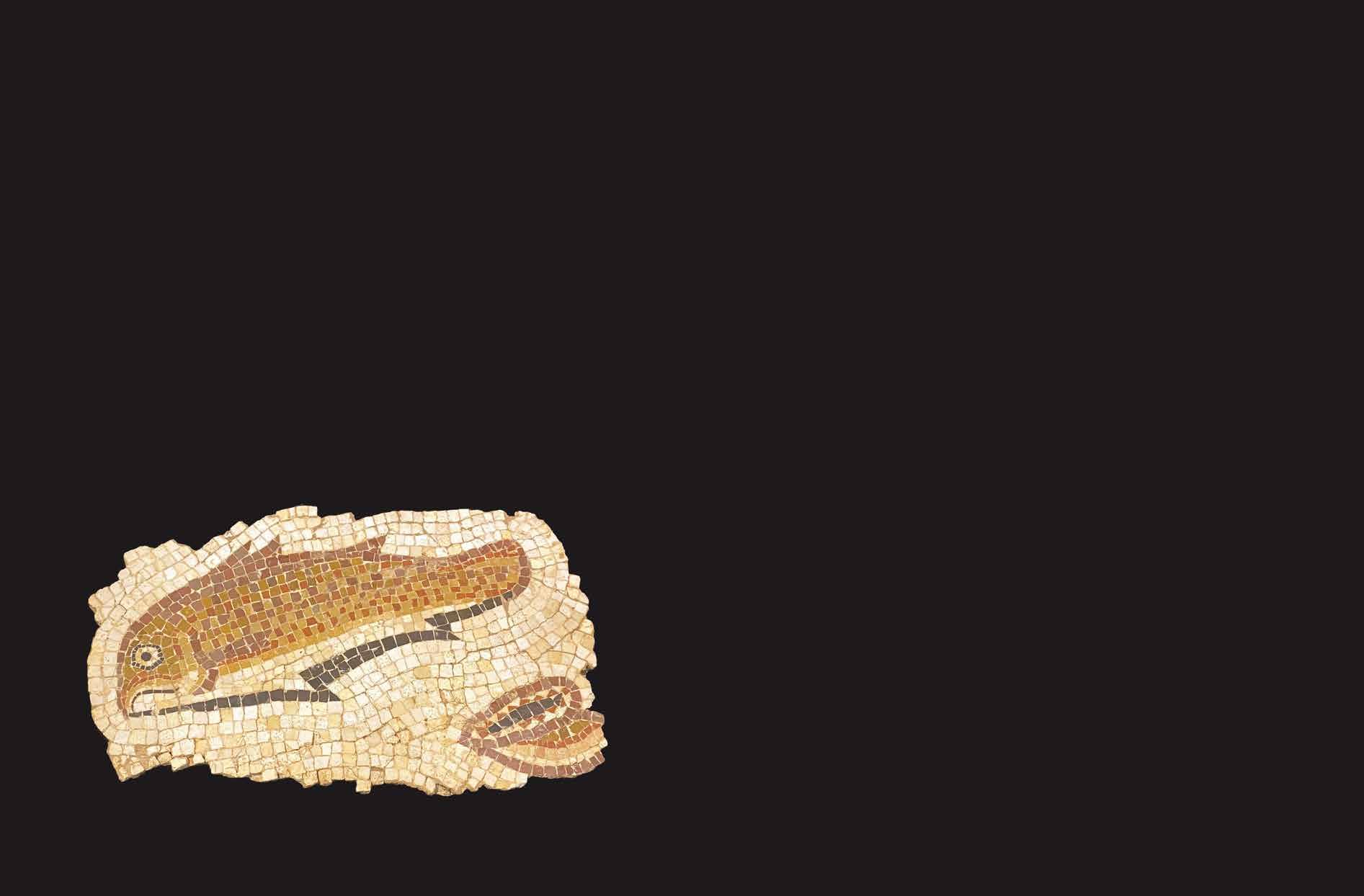
Artes antigas Ancient art
< páginas anteriores | previous pages 151. Fragmento de mosaico romano em calcário e mármore, com provável representação de um salmonete (Mullus sp.) * Milreu, Faro Fragment of a Roman mosaic in limestone and marble, with probable representation of a mullet (Mullus sp.) * Milreu, Faro. Acervo | Collection — Museu Nacional de Arqueologia, Inv. 18693
Arte rupestre pré-histórica da Gruta de Altamira com cerca de 13.000 a 23.000 anos de idade, com pigmentos naturais ocres (argilas e óxidos de ferro) e carvão, aplicados nos tectos e paredes da gruta. Prehistoric rock art from the Altamira Cave, between 13,000 and 23,000 years old, with natural ocher pigments (clays and iron oxides) and coal, applied to the ceilings and cave walls. 152. Pintura de veado fêmea (Cervus elaphus) Painting of female deer (Cervus elaphus). 153. Pintura de bisonte-das-estepes (Bison priscus) Painting of steppe bison (Bison priscus).

Os Primórdios da Ilustração Naturalista
A moderna ilustração científica assenta na observação dos objetos e na sua representação o mais realista e objetiva possível. Reconhece-se, de forma relativamente consensual, que surgiu na época renascentista (essencialmente a partir do século XV). Mas isso não significa que a ilustração científica, em termos latos, se tenha iniciado neste período. As primeiras sociedades de homens modernos (Homo sapiens), no Paleolítico, observavam as migrações dos animais e os seus comportamentos e, ao registarem em desenho uma parte dessas observações, nas paredes de grutas e abrigos, com as tintas, pincéis e técnicas arcaicas dessa época, iniciaram as primeiras ilustrações de natureza. Nos milénios que se seguiram diversificaram-se as técnicas e materiais de desenho assim como as perspetivas de observação do mundo natural. Os frescos nos túmulos egípcios ou palácios gregos, os mosaicos romanos, ou os primeiros códices e herbários ilustrados em velhos pergaminhos, são disso magníficos exemplos. Assim evoluiu a ilustração naturalista, aprimorando-se o sentido da observação e da comunicação do mundo natural, dois dos principais desígnios dos modernos ilustradores científicos!
The Beginnings of Naturalist Illustration
Modern scientific illustration is based on the observation of objects, and in their most realistic and objective representation possible. The relatively general consensus is that it originated during the Renaissance (mainly from the 15th century onwards). That does not mean, however, that scientific illustration, in its broad sense, began during that period. The first societies of modern man (Homo sapiens), in the Paleolithic era, observed animal migration and its behaviors, and by registering part of those observations in the form of drawings on the walls of caves and shelters, using the paints, brushes and archaic techniques of the times, they initiated the first illustrations of nature. The following millennia witnessed the diversification of drawing materials, techniques, and observational perspectives of the natural world. The frescos in Egyptian tombs and Greek palaces, Roman mosaics, or the first codices and herbaria illustrated on old parchments, are magnificent examples of those. And thus, naturalist illustration evolved, enhancing the sense of observation and communication of the natural world — two of the main goals of modern scientific illustrators!
Mosaicos romanos, provavelmente de perdiz-cinzenta (Perdix perdix) Roman mosaics, probably of a grey partridge (Perdix perdix). 154. Cidade de Kos, Grécia | Kos town, Greece. 155. Basílica de Philippopolis, cidade de Plovdiv, Bulgária Basilica of Philippopolis, Plovdiv town, Bulgaria.
152.
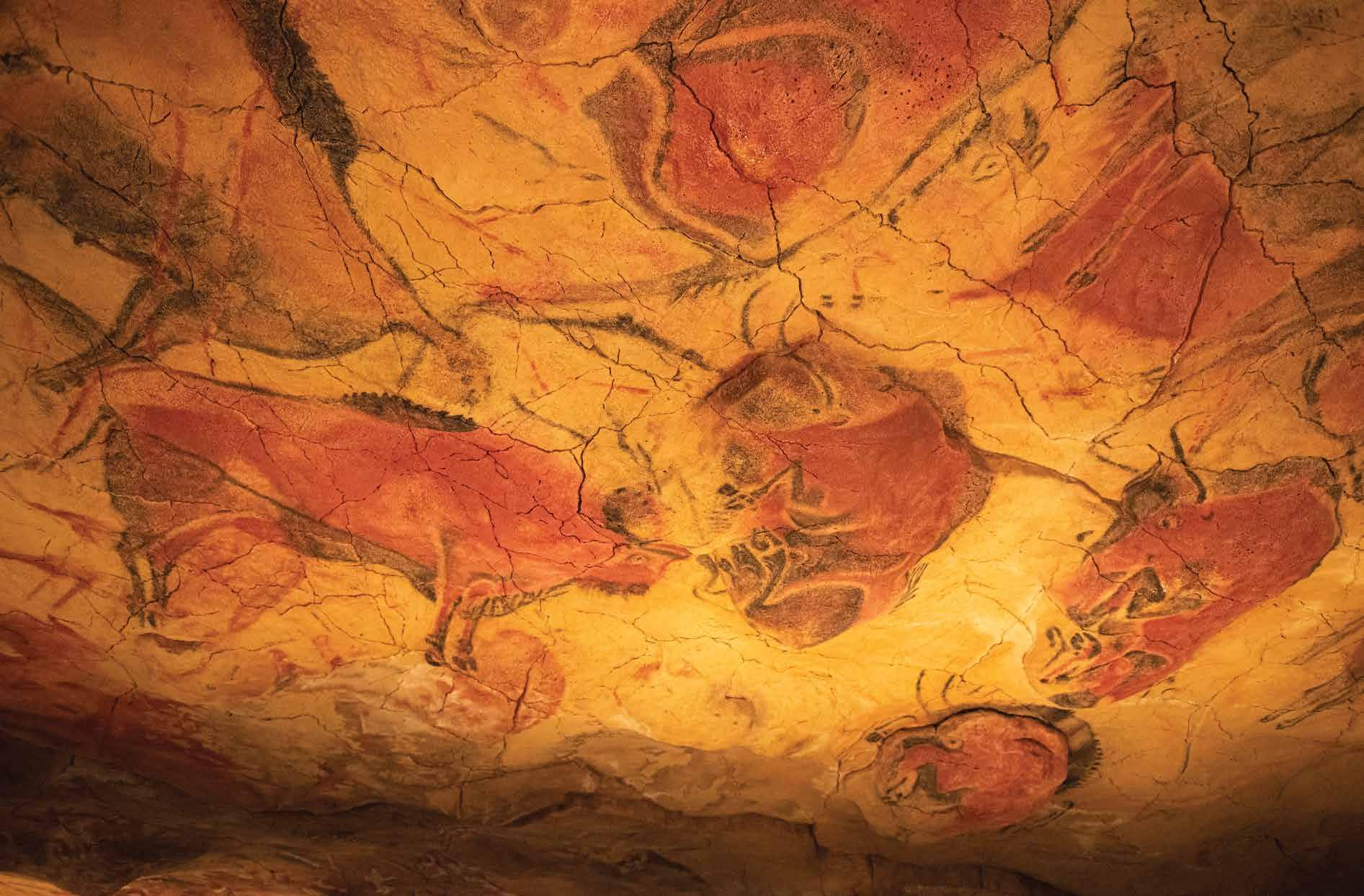
156. Arte rupestre pré-histórica da Gruta de Altamira — galeria de bisonte-das-estepes (Bison priscus). Prehistoric rock art from the Altamira Cave — Steppe bison gallery (Bison priscus).
VI.
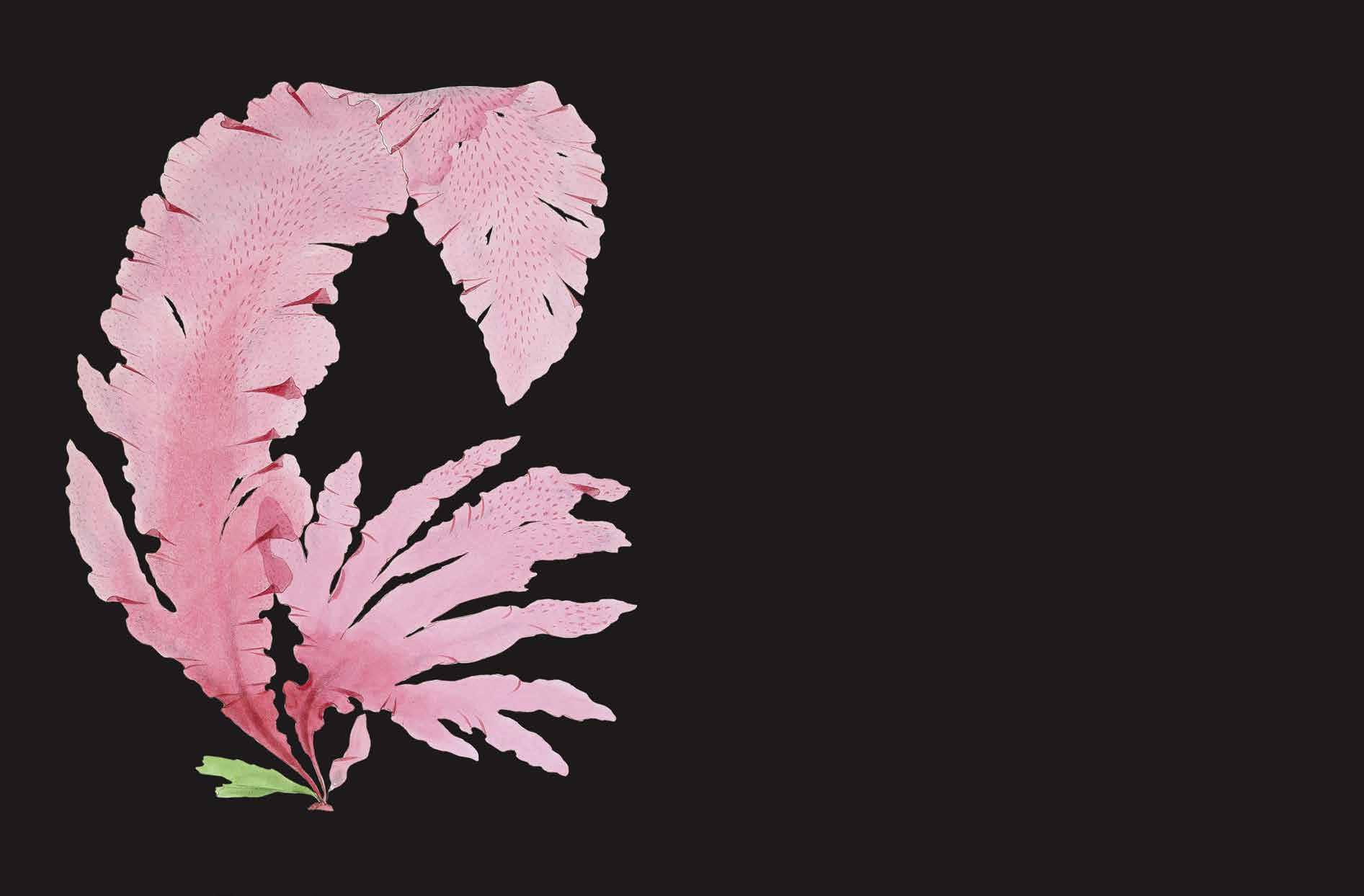
Viagens de descoberta Voyages of discovery
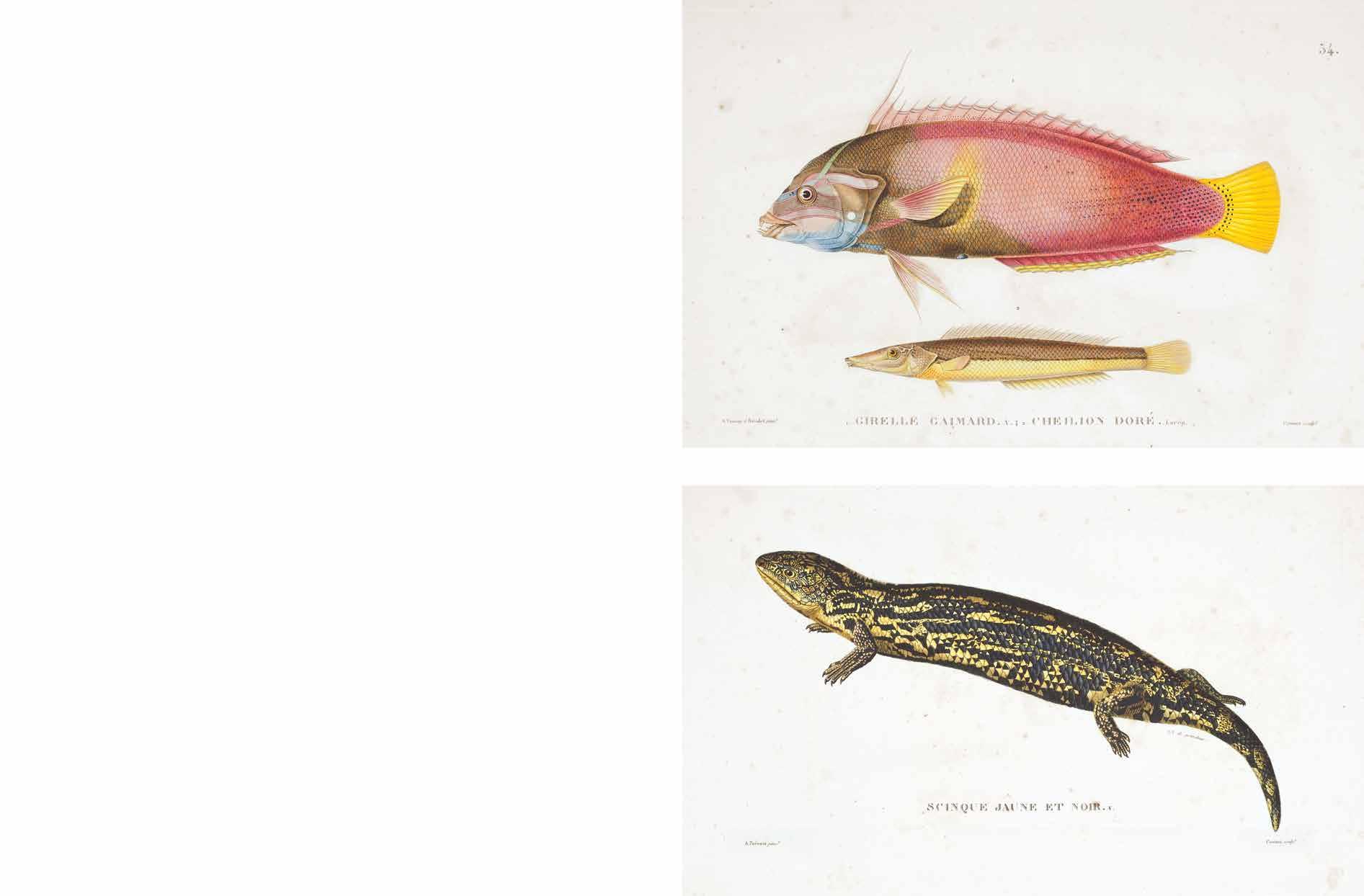
Novos Mundos – Novas Perspetivas de Desenho
As viagens de descoberta e conquista dos Portugueses e de outros povos europeus, a partir do século XV, permitiram uma enorme troca e aumento do saber e da cultura, sobretudo aquelas que foram patrocinadas em parte, ou no todo, como campanhas de conhecimento científico: para cartografar territórios desconhecidos; para documentar usos e costumes locais; para recolher amostras da diversidade biológica e geológica; ou para observar fenómenos naturais, biológicos ou astronómicos. Muitas destas viagens ocuparam os exploradores, naturalistas e ilustradores que nelas participaram, durante anos de trabalho, por vezes décadas: quer no registo e coleção de objetos naturais e informações durante a própria expedição; quer durante os muitos anos de estudo para tratamento e publicação dos dados, já nos seus gabinetes particulares, museus e outras instituições de ciência. Assim surgiram as mais espetaculares obras ilustradas de história natural, porque o livro impresso, com imagens originais, vívidas, coloridas e detalhadas, passou a ser o meio privilegiado de divulgação do conhecimento científico.
< páginas anteriores | previous pages 157. Macroalga vermelha (Nitophyllum crozieri = Cryptopleura crozieri), recolhida durante a expedição dos navios H.M.S.Erebus e H.M.S. Terror, nas águas frias em redor das ilhas Hermite, no Cabo Horn, na extremo austral da América do Sul. Red macroalgae (Nitophyllum crozieri = Cryptopleura crozieri), collected during the expedition of the H.M.S. Erebus and H.M.S. Terror, at the cold waters around the Hermite Islands, Cape Horn, in the southern end of South America. Impressão em litografia, pintada à mão * Walter Hood Fitch (ilustrador e litógrafo) in “The Botany of the Antarctic Voyage of H.M. discovery ships Erebus and Terror in the Years 1839-1843, under the command of captain Sir James Clark Ross. Vol.2”, 1844-47 Hand-painted lithography printing * Walter Hood Fitch (illustrator and lithographer) in “The Botany of the Antarctic Voyage of H.M. discovery ships Erebus and Terror in the Years 1839-1843, under the command of captain Sir James Clark Ross. Vol.2”, 1844-47
Acervo | Collection Ernst Mayr Library of the MCZ, Harvard University Herbarium, Botany Libraries
New Worlds — New Drawing Perspectives
As of the 15th century, the voyages of discovery and conquest by the Portuguese and other European peoples, allowed for a massive exchange and increase in knowledge and culture, above all on voyages which were either partially of wholly financed as campaigns for scientific knowledge: to chart unknown territories; to document local usages and customs; to gather samples of the biological and geological diversity; or to observe natural, biological or astronomical phenomena. Many of these voyages took up years, or even decades of work for the explorers, naturalists and illustrators who participated in them: be it in the logging and collecting of natural objects and data during the actual expedition; be it in the many years of study in order to process and publish that data, once back in their private offices, museums and other scientific institutions. Thus were born some of the most spectacular illustrated works of natural history, as the printed book, with original, vivid, colorful and detailed images, became the privileged media for disseminating scientific knowledge.
A expedição francesa dos navios L’Uranie e La Physicienne decorreu entre os anos de 1817 e 1820, sob direção do comandante Louis Claude de Saulces Freycinet, com o objetivo de fazer uma série de observações e registos geográficos, astronómicos, metereológicos e do magnetismo terrestre, na sua volta ao mundo. Durante a viagem foram também recolhidos muitos espécimes de história natural, nomeadamente nos territórios portugueses do Brasil e Timor. The French expedition with the ships L’Uranie and La Physicienne took place between the years 1817 and 1820, under the direction of commander Louis Claude de Saulces Freycinet, to take a series of observations and records on geographic, astronomical, meteorological and terrestrial magnetism issues, on its journey around the world. During the voyage many specimens of natural history were also collected, namely in the Portuguese territories of Brazil and Timor. 158. Caralete-africano ou peixe-palhaço (Coris gaimard = Coris cuvieri) - em cima; madonoli ou lamboso (Cheilio auratus = Cheilio inermis) - em baixo; ambas as espécies ocorrem nas águas de Moçambique e Timor African wrasse or false clowwrasse (Coris gaimard = Coris cuvieri) - on top; cigar wrasse (Cheilio auratus = Cheilio inermis) - on bottom; both species occur in the waters of Mozambique and Timor. 159. Escinco-malhado-de-língua-azul (Tiliqua nigrolutea) Blotched bluetongue lizard. Impressão em calcografia colorida à mão * Antoine Germain Bévalet, Jean Louis Denis Coutant e Aimé-Adrien Taunay (ilustradores e gravadores) in “Voyage autour du monde, fait par ordre du Roi, sur les corvettes de S. M. l’Uranie et la Physicienne, pendant les années 1817, 1818, 1819 et 1820”, 1824 Hand-colored calcography printing * Antoine Germain Bévalet, Jean Louis Denis Coutant and Aimé-Adrien Taunay (illustrators and engravers) in “Voyage autour du monde, fait par ordre du Roi, sur les corvettes de S. M. l’Uranie et la Physicienne, pendant les années 1817, 1818, 1819 et 1820”, 1824
Coleção particular | Private collection — N.Farinha 159.
No início, as viagens de descoberta científica assumiram-se essencialmente como campanhas de coleção avulsa de objetos naturais, que originaram os “gabinetes de curiosidades” ou “quartos das maravilhas”, onde o exotismo e a raridade animal, vegetal e mineral, enchiam de orgulho os seus ricos proprietários. A viagem à Jamaica entre 1687-88 do irlandês Hans Sloane, médico do governador dessa colónia inglesa, é um destes exemplos. De forma gradual, essas viagens passaram a ter métodos e objetivos científicos, envolvendo mais meios e investimentos avultados. Assim se fizeram as viagens dos navios britânicos H.M.S. Erebus e H.M.S. Terror aos mares antárticos entre 1839-43; ou a mítica expedição de circum-navegação do H.M.S. Challenger entre 1872-76, onde se fundaram os princípios da moderna oceanografia. In the beginning, the voyages of scientific discovery were essentially campaigns for the random collection of natural objects, leading to the creation of the “Cabinets of Curiosities” or “Cabinets of Wonder”, whose animal, vegetable and mineral exoticism and rarity filled their rich owners with pride. The 1687-88 voyage to Jamaica of Hans Sloane, the Irish physician to the governor of that English colony, is one such example.
160. Little by little, these voyages began to include scientific methods and objectives, involving more resources and substantial investment.
The voyages of the British ships H.M.S. Erebus and H.M.S. Terror to the Antarctic seas (1839 to 1843) were made in this way, as was the mythical 1872-1876 expedition of the H.M.S. Challenger, circumnavigating the globe and laying the foundation of modern oceanography.
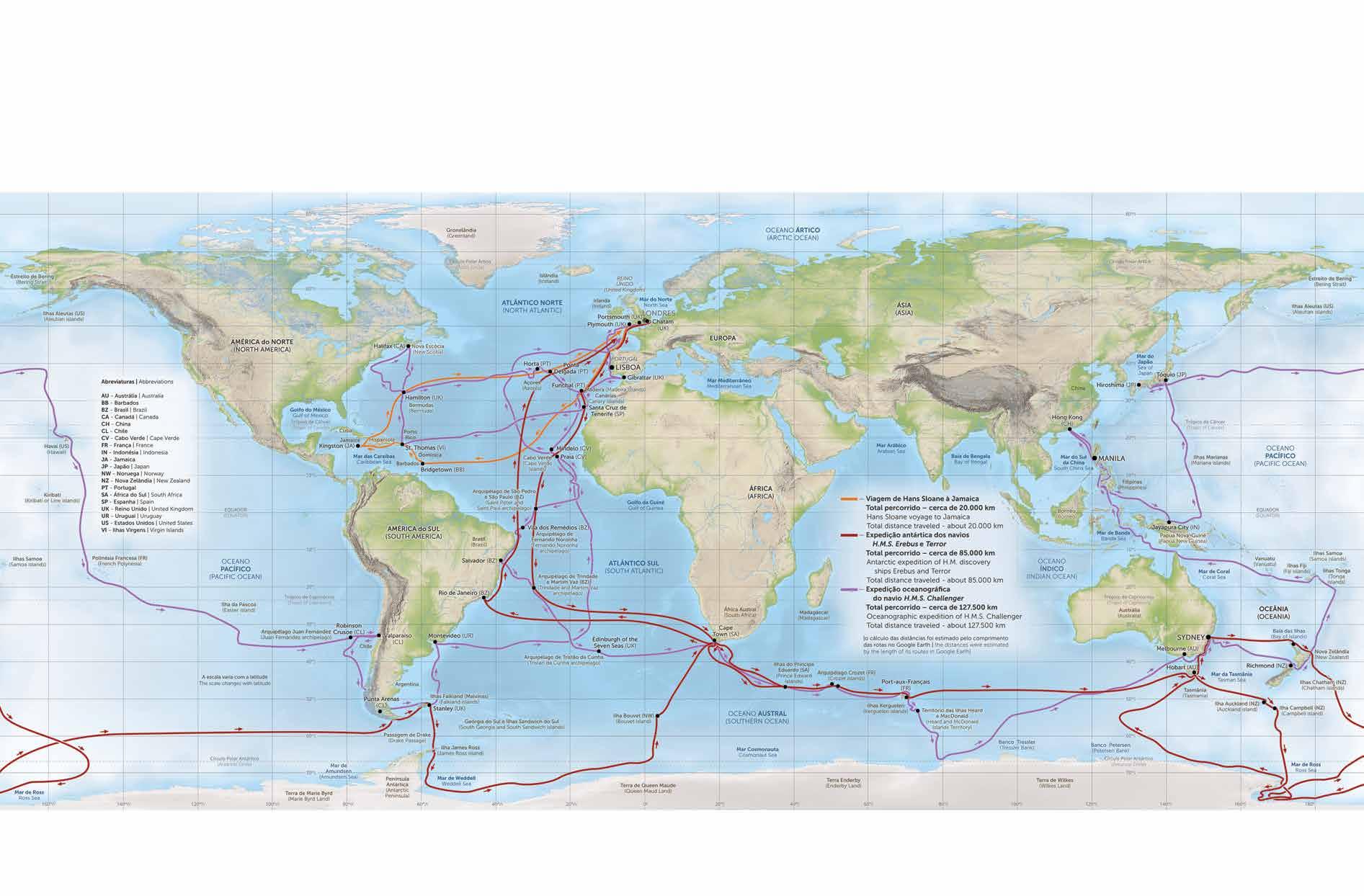
161. Malvavisco (Malvaviscus arboreus) | Turkcap or wax mallow.
162. Cacaueiro (Theobroma cacao) | Cocoa tree. 163. Gengibre (Zingiber officinale) | Ginger. Hans Sloane (1660-1753) foi um médico, naturalista e colecionador irlandês que desde a sua juventude se interessou pelos temas de história natural. Em 1687, embarca para a Jamaica e viaja por várias ilhas caribenhas, recolhendo uma grande coleção de espécimes, identificando e tomando notas detalhadas sobre cerca de 800 novas espécies de plantas.

Hans Sloane (1660-1753) was an Irish physician, naturalist and collector with an interest for natural history since his youth. In 1687, he set sail for Jamaica, from where he travelled to various Caribbean islands, gathering a large collection of specimens, identifying and taking detailed notes on about 800 novel plant species.
164. 165. 161 - 163. Plantas da Jamaica | Plants from Jamaica. Impressão em calcografia * Hans Sloane (autor) in “Voyage to the Islands Madera, Barbados, Nieves, S. Christophers, and Jamaica”, 1707-25 | Calcography printing * Hans Sloane (author) in “Voyage to the Islands Madera, Barbados, Nieves, S. Christophers, and Jamaica”, 1707-25 Acervo | Collection — John Carter Brown Library
164. Cana-de-açucar (Saccharum officinarum) | Sugarcane. 165. Cacho de bananas (Musa sp.) | Banana stem. 166. Engenho de moagem de cana | Sugarcane mill. Impressão em calcografia * Nicolas Poilly (gravador) e Hans Sloane (autor) in “Histoire de la Jamaique” (1751) Copper-engraved printing * Nicolas Poilly (engraver) and Hans Sloane (author) in “Histoire de la Jamaique” (1751)
Coleção particular | Private collection — N.Farinha
166.










